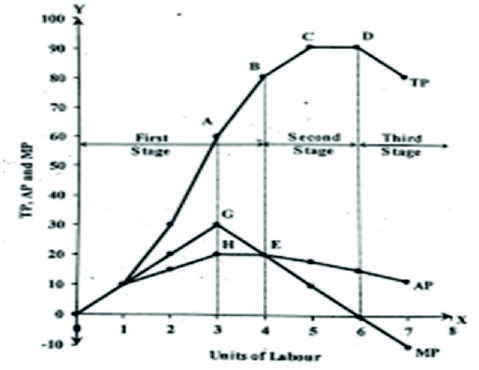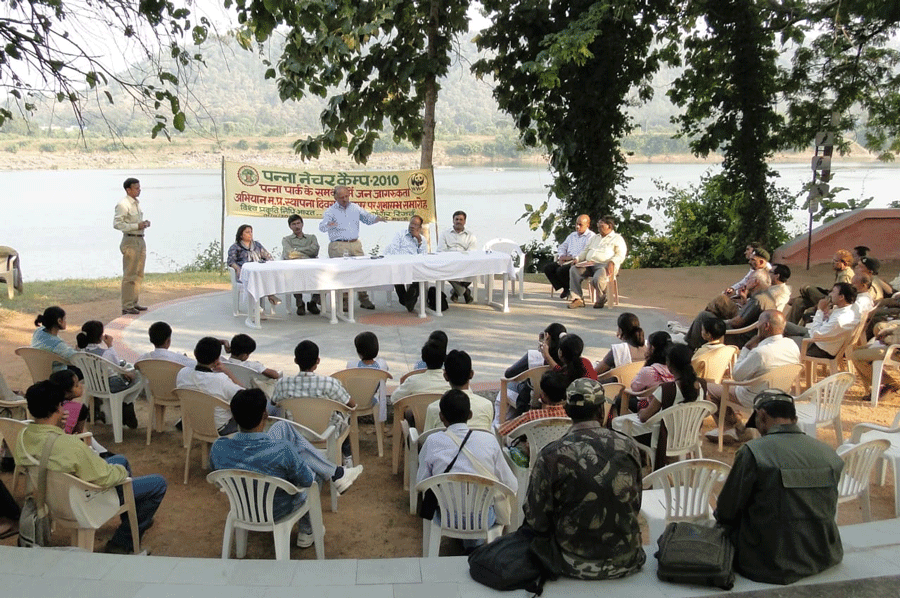APPLICATION OF THE LAW OF VARIABLE PROPORTION IN AGROFORESTRY PRODUCTION
-Dr. S. P. Singh, Rishikesh Shrikant Patil
Abstract
This paper is an outcome of the assignment of Economics of Agroforestry Course of C3F 24-25 batch professionals. This paper discusses about the application of law of variable proportion in agroforestry production. Agroforestry is an approach towards the land management that integrates trees, crops, and livestock to create a more productive and sustainable farming system. It balances ecological benefits with economic gains, making it a valuable strategy for modern agriculture. A key concept that significantly influences agroforestry is the ‘Law of Variable Proportion,’ a microeconomic principle that explains how altering specific inputs-such as labour, fertilizers, irrigation, or plant density-affects productivity while the land remains a fixed resource. Understanding this law can enable farmers to make informed decisions about resource use, maximizing output without wasting inputs.
The first objective of this paper is toanalyse the Law of Variable Proportion applies to agroforestry. Secondly, to examine the stages of production under different input levels. Thirdly, to evaluate a case study from Nashik district, demonstrating the law’s practical implications. And lastly to provide recommendations for optimizing resource allocation in agroforestry systems.
This paper explores how the Law of Variable Proportion applies to agroforestry, investigating how different input levels influence crop and tree growth. By examining the three phases of this law-increasing returns, diminishing returns, and negative returns- helps us to better understand the tipping points for efficiency and sustainability. A real-world case study from Nashik district, Maharashtra, offers insights into practical challenges and solutions, assisting farmers, policymakers, and researchers develop more effective strategies for sustainable agroforestry.
Key words: variable proportion, returns, Product
1. INTRODUCTION:
The Law of Variable Proportion, a fundamental concept in microeconomics, explains the relationship between input levels and output in the short run when one input is varied while others remain fixed. This law is particularly relevant in agroforestry, where land remains a fixed factor while labor, capital, fertilizers, and tree density can be adjusted. Understanding how changes in these variable inputs affect crop and tree yields is crucial for optimizing agroforestry systems. Agroforestry integrates trees with agricultural crops and livestock to enhance productivity and sustainability. However, excessive or insufficient use of variable factors can lead to diminishing returns, affecting overall farm efficiency. Farmers and policymakers can determine the optimal input levels required to maximize output without over-exploiting resources by applying the Law of Variable Proportion.
1.2 Research Problem: Farmers in the Nashik district of Maharashtra often face challenges in agroforestry due to inefficient input utilization. Overusing fertilizers, labor, and irrigation in a fixed land area usually leads to declining productivity after a certain point, proving the Law of Variable Proportion in real-world agroforestry scenarios. The key issue is identifying the ideal combination of inputs to enhance long-term sustainability and profitability in agroforestry practices.
1.3 Objectives
- To analyse the Law of Variable Proportion applies to agroforestry.
- To examine the stages of production under different input levels.
- To evaluate a case study from Nashik district, demonstrating the law’s practical implications.
- To provide recommendations for optimizing resource allocation in agroforestry systems.
2. UNDERSTANDING THE LAW OF VARIABLE PROPORTION AND METHODOLOGY:
2.1 Explanation of the Law
The Law of Variable Proportion, a fundamental principle in microeconomics, describes the relationship between input levels and output in the short run, where at least one factor of production (such as land) remains fixed. In contrast, other inputs (such as labor, fertilizers, and irrigation) are varied. This law is particularly relevant in agricultural and agroforestry systems, where optimizing input combinations is critical for maximizing yield, sustainability, and economic efficiency. The law operates in three distinct stages, reflecting different production efficiency phases as more units of a variable input are added to a fixed factor.
Stage 1: Increasing Returns (Stage of Diminishing Cost)
- At the initial production phase, adding units of the variable input (e.g., labor, fertilizers, water) leads to a more than proportional increase in total output.
- This occurs because the fixed factor (land) is underutilized, and additional inputs improve productivity by enhancing resource efficiency. For example, in an agroforestry system, increasing the application of organic manure and irrigation may significantly boost tree growth, leading to a rapid rise in biomass accumulation.
- Marginal Product (MP) and Average Product (AP) increase, indicating that each additional input unit contributes more to overall production.
- Example in Agroforestry: In the initial stage of tree plantation, applying fertilizers, mulching, and proper irrigation improves soil fertility and moisture retention, leading to faster root establishment and higher sapling survival rates.
Stage 2: Diminishing Returns (Stage of Optimal Utilization)
- As more variable inputs are added, the rate of increase in total output slows down. Though production continues to rise, it does so at a decreasing rate.
- The Marginal Product (MP) begins to decline, while the Total Product (TP) still increases slower. This is due to the saturation of the fixed factor, which limits the efficiency of additional inputs.
- Overcrowding, nutrient depletion, or excessive irrigation may occur, reducing the effectiveness of each new input unit.
Example in Agroforestry: After an optimal level of irrigation and fertilization, further inputs provide diminishing benefits. If too many plants are grown on a fixed piece of land, canopy competition may limit sunlight penetration, reducing the rate of photosynthesis and slowing down further growth.
Stage 3: Negative Returns (Stage of Overcrowding and Declining Productivity)
- Beyond a certain threshold, adding more variable inputs leads to an absolute decline in total output. This happens when the fixed factor (land) overloads excessively, leading to inefficiencies.
- The Marginal Product (MP) becomes negative, meaning additional inputs contribute negatively to total output. In extreme cases, total production may start decreasing.
- This can occur due to excessive fertilization causing soil toxicity, over-irrigation leading to waterlogging, or overcrowding reducing resource availability per plant.
Example in Agroforestry:
Excessive fertilizer application may lead to soil salinity, negatively impacting root function. Similarly, overplanting trees beyond the carrying capacity of land results in stunted growth and competition for limited water and nutrients, reducing overall yield.
2.2 Practical Implications
- Understanding the Law of Variable Proportion helps optimizeagriculture, agroforestry, and ecological restoration input levels.
- Stage 1 should be fully utilized to enhance productivity, but over-application of inputs leading to Stage 3 should be avoided to maintain sustainability.
- Precision farming techniques, such as site-specific nutrient management (SSNM), controlled irrigation, and agroforestry design, ensure that resources are efficiently allocated without surpassing the optimal utilization stage.
Part-III
Analysis
3. APPLICATION OF THE LAW OF VARIABLE PROPORTION IN Agroforestry
3.1 Importance in Agroforestry Systems
Agroforestry is a complex land-use system where multiple crops and tree species are cultivated within a shared landscape. Combining trees, shrubs, and crops requires optimal resource allocation to maintain long-term productivity and ecological balance. The Law of Variable Proportionis crucial in understanding the relationship between variable inputs (such as labor, fertilizers, irrigation, and tree density) and the fixed factor (land) guiding sustainable agroforestry practices.
The principles of this law help in:
1. Optimizing Tree Density for Balanced Crop Productivity
- The spatial arrangement and number of trees per hectare significantly impact overall productivity in agroforestry systems. If tree density is too high, crops may experience light interception, root competition, and reduced access to soil moisture and nutrients, leading to diminished yields. Conversely, very low tree density may result in underutilization of land and reduced ecosystem benefits such as carbon sequestration, soil stabilization, and biodiversity enhancement.
- The Law of Variable Proportion provides a framework to determine the ideal tree-to-crop ratio, ensuring that the marginal productivity of additional trees remains positive while maintaining sufficient growing conditions for associated crops.
- Scientific Example: In an agroforestry model integrating Dalbergiasissoo (Indian rosewood) with wheat, studies have shown that an optimal tree density of 100-150 trees per hectare maintains sufficient sunlight penetration while improving soil fertility through nitrogen fixation. Beyond this density, wheat yields decline due to excessive shading and root competition.
2. Efficient Management of Labour and Input Costs
- The law helps in strategic labour allocation by identifying the stage at which additional labor contributes positively to productivity. If too many workers are assigned to a fixed plot, the marginal utility of each additional labour unit diminishes, leading to inefficiencies and unnecessary costs.
- Input optimization (fertilizers, irrigation, and pest control) follows the same principle. Initially, fertilizers enhance soil fertility and plant growth (Stage 1: Increasing Returns). However, beyond a certain level, excess fertilizers saturate the soil without proportionate yield benefits (Stage 2: Diminishing Returns). Overuse can cause soil degradation, nutrient leaching, and economic losses (Stage 3: Negative Returns).
- Scientific Example: In silvopastoral systems combining Leucaenaleucocephala trees with fodder crops, applying 10 kg of organic manure per tree optimizes nitrogen release, improving biomass yield. However, beyond 20 kg per tree, additional manure shows negligible benefits while increasing nutrient runoff risk.
3. Enhancing Long-Term Sustainability by Preventing Resource Depletion
- Sustainable agroforestry systems require balanced resource consumption to maintain productivity over multiple seasons. The law informs decision-making by helping farmers avoid excessive input applications that lead to soil nutrient depletion, water stress, and land degradation.
- The threshold for sustainable input use is determined by the stage at which additional inputs no longer enhance output, ensuring that natural resources remain productive without crossing the ecological tipping point.
- Scientific Example: In agroforestry systems with Acacia nilotica and intercropped legumes, irrigation scheduling based on the law’s stages ensures efficient water use. Initially, increasing irrigation improves growth (Stage 1), but beyond a 50% field capacity threshold, excessive irrigation reduces soil aeration, increases root diseases, and lowers productivity (Stage 3).

Above figure shows the three stage of law of variable proportion. Stage one show Increasing returns /product/cost, second shows Constant returns /product/cost and Third stage shows the diminishing returns/product/cost.
This applies in Agriculture and forestry sector. A case study of Nashik district is an example of the same.
3.2 Example from Nashik District, Maharashtra
Case Study: Agroforestry in a Grape and Teak-Based System in Nashik
Nashik district is widely recognized for its prominence in viticulture, particularly grape cultivation. Many farmers incorporate Teak (Tectonagrandis) within agroforestry systems to enhance economic resilience and optimize land utilization. This integration allows for diversified income streams while contributing to ecological stability. The following case study examines the application of the Law of Variable Proportion in this context, analyzing how variations in input factors influence overall productivity and sustainability within agroforestry-based land management systems.
Farmer Profile:
- Location: Sinnar Taluka, Nashik District, Maharashtra
- Land Area: 5 acres
- Agroforestry Model: Grape (Vitisvinifera) + Teak (Tectonagrandis)
- Variable Inputs Considered: Irrigation, fertilizers, labor, plant density
Observations Over Three Stages:
3.3 Key Learnings from the Case Study
1. Optimal Tree Density for Agroforestry Efficiency:
Maintaining an appropriate density of 15-20 teak (Tectonagrandis) trees per acre balances productivity in an agroforestry system. Excessive tree density can result in excessive shading, reducing grapevine photosynthetic efficiency. Farmers can enhance soil stability, promote microclimatic benefits, and support long-term sustainability without compromising grape yield by ensuring an optimal number of trees.
| Stage | Description | Impact on Grape and Teak Yield |
| Stage 1: Increasing Returns | Initially, the farmer increased irrigation and fertilizers for grapes and teak. The yield improved as soil conditions and tree growth enhanced. | Increased grape production and better teak sapling growth. |
| Stage 2: Diminishing Returns | Further addition of fertilizers and irrigation led to overcrowding, reducing grape quality and teak’s growth rate. | The growth rate slowed, requiring more space management. |
| Stage 3: Negative Returns | Excessive plantation of teak trees led to a shade effect, reducing grapevine sunlight, which led to fungal diseases and lower grape yields. | Decrease in grape quality and income loss. |
2. Balanced Irrigation for Resource Efficiency and Plant Health: Precision irrigation is crucial in this integrated system, where teak and grape crops share water resources. Over-irrigation depletes groundwater reserves and increases humidity levels, creating a favorable environment for fungal pathogens that can harm grapevines. Implementing regulated irrigation techniques such as drip irrigation ensures water is delivered efficiently to plant roots, optimizing water uptake and reducing disease susceptibility.
Strategic Spacing to Maximize Sunlight Penetration and Crop Productivity: The spatial arrangement of trees and crops plays a vital role in ensuring adequate light availability. Proper spacing prevents excessive competition for sunlight, allowing grapevines to receive sufficient light for optimal photosynthesis, fruit development, and sugar accumulation. This arrangement also facilitates air circulation, reducing the risk of pest infestations and fungal diseases. Farmers can achieve mutual benefits between tree and crop components by aligning agroforestry design with ecological principles, improving overall land productivity.
4. CONCLUSION AND RECOMMENDATIONS:
4.1 Conclusion:
Applying the Law of Variable Proportion in agroforestry underscores the necessity of optimizing input variables such as labor, fertilizers, irrigation, and tree density to maximize productivity and sustainability. Findings from the Nashik district case study reveal that while moderate and well-balanced inputs enhance productivity, excessive application diminishes marginal returns, ultimately reducing efficiency. Resource competition intensifies when inputs surpass an optimal threshold, negatively impacting tree growth and crop yield. Thus, strategic input management is crucial for maintaining long-term sustainability in agroforestry systems.
4.2 Recommendations: To enhance the efficiency and sustainability of agroforestry systems, the following evidence-based recommendations are proposed:
1. Optimized Tree Density Management: Teak (Tectonagrandis) should be spaced strategically to prevent excessive grapevine competition, ensuring balanced resource allocation.
2. Precision-Based Input Application: Irrigation and fertilization should be aligned with soil health assessments and crop-specific requirements, minimizing resource depletion and unnecessary financial investment.
3. Integration of Advanced Agroforestry Techniques: Adoption of contour planting, drip irrigation, and scientific canopy management can optimize water use, enhance soil conservation, and improve overall system efficiency.
4. Farmer Capacity Building and Knowledge
Dissemination: Targeted training programs and workshops should equip farmers with the latest scientific practices in agroforestry, empowering them to make data-driven decisions and optimize input utilization effectively.
Acknowledgement:
I am equally grateful to Dr. K Ravichandran, IFS, Director IIFM, Bhopal Dr.C P Kala, Chairperson C3F and Dr. Bhimappa Kittur, Associate Coordinator, C3F at the Indian Institute of Forest Management, Bhopal, for facilitating this opportunity. My deepest thanks alsogoto Prof. S.P. Singh, my Course Coordinator Economics of Agroforestry, for his unwavering guidance, constructive feedback, and constant encouragement throughout work. Lastly, authors acknowledge Prof. Rajiv Kumar, Chairman, GIDS, Prof. Harsh Sharma, Director, GIDS, Dr. K. Srinivasa Rao, Convenor, Dr. D. Ramdas, Research Consultant-GIDS, Dr. A.Κ. Singh, Consultant, GIDS for inviting in the National Conference.


Author are: 1. Associate Professor, Environment and Developmental
Economics, Indian Institute of Forest Management, Bhopal
2. Student of C3F 24-25 Batch, Indian Institute of Forest Management, Bhopal












